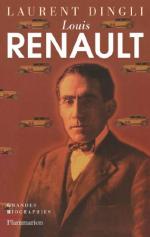|
This section contains 335 words (approx. 2 pages at 300 words per page) |
World of Invention on Louis Renault
In 1898, the gifted and innovative Frenchman Louis Renault built his first car. Only twenty-one years old, he converted a motorized tricycle into a "minicar" by adding another road wheel and a transmission system. The car he designed had a three-speed gearbox plus reverse. His gearbox provided a direct drive, with no gear wheels transmitting power on the high gear. This was an improvement on earlier models that transmitted each speed indirectly through a pair of gear wheels, thus adding more noise and creating frictional losses. His innovation of putting universal joints in the drive shaft to enable the axle to rise and fall on springs was also a boon to the industry. The vehicle was quiet, flexible, and lighter than most other cars in those days. The car was such a success that he and his brothers, Fernand and Marcel, united in 1898 to found the Société Renault Frères.
Renault cars were extremely popular on the racing circuit and brought the company a great deal of success. Unfortunately, the personal lives of the founding brothers were often tragic. In 1903, Louis's brother Marcel was killed in a racing accident. At that point, Louis gave up racing to concentrate on building his automobile enterprise. He was able to use knowledge gained from his racing days to design a number of vehicles. Renault produced five vehicle models in 1905; he introduced a city passenger bus in Paris in 1906; and his company's tanks escorted French troops during World War I. After the war, the company branched into production of farm equipment and industrial and marine machinery. The Société Renault Frères grew to become France's largest manufacturer and exporter of motor vehicles.
Renault continued his innovative work in the industry. During World War II, his company produced military equipment under German occupation. After France's liberation, he was jailed on charges of collaboration with the Nazis. He died awaiting trial in 1944, and his company was subsequently nationalized by the French government.
|
This section contains 335 words (approx. 2 pages at 300 words per page) |


